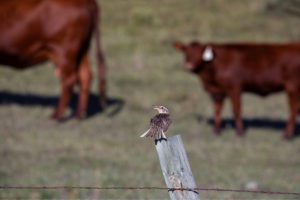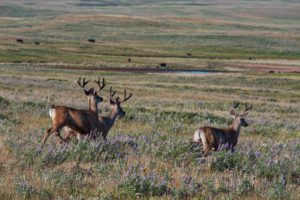Source: Canadian Roundtable for Sustainable Beef
If you enjoy majestic native grasslands, beautiful songbirds and abundant wildlife on healthy habitats, maybe consider thanking a cattle rancher.
In Canada, beef cattle ranchers are the stewards of over 35 million acres of temperate native grasslands across the west. These landscapes are noted as one of the most endangered ecosystems anywhere on earth. Mostly, the loss of native grasslands is through conversion to annual cropland, at least those lands conducive to cultivation. Still many other acres are lost to development, especially urban and resource expansion.
The vast native open and forested grasslands of much of North America’s west evolved under historic disturbance by grazers like bison, elk, antelope and deer, as well as by fire. The bison, now mostly gone from these landscapes, have been replaced by beef cattle in a great number of grassland regions. That’s important because grazing by large herbivores is vital to the continued health of these open and forested native grassland ecosystems supporting important wildlife species. Cattle grazing is now the primary tool providing the disturbance these ecosystems require for health, productivity and biodiversity.
These ecosystems and their wildlife inhabitants are quite complex. Thus, there really isn’t a single approach to grazing management on these lands if the aim is to maintain or enhance the ecosystem health and biodiversity. This is particularly evident in the habitat requirements of grassland songbirds, whose populations in many cases are waning and ranchers are helping protect and enhance the varied habitats. Some songbirds prefer lightly grazed grasslands while others need highly disturbed habitat to thrive. And still others like disturbance in that mid-level range. Cattle grazing is known to create the mosaic of structure and litter within grasslands and pastures needed by songbirds.

Ranchers know about these interrelationships, and they know how to properly manage their grazing cattle to create those right mosaics of native grassland habitats for the variety of species requiring varied disturbance levels at specific times in their reproductive, rearing and feeding stages. Sounds complex for sure, but it’s being done. And studies show areas grazed by large herbivores like cattle have elevated levels of plant diversity than non-grazed areas. Also, moderately grazed areas have higher plant diversity than heavily grazed areas. In short, research shows that biodiversity is higher under some level of grazing when compared to no grazing at all.
Among its many initiatives the Canadian beef industry is fully committed through 2030 industry goals to maintaining those 35 million acres of grasslands under beef producer care, and to maintain a network of natural landscapes and healthy functioning ecosystems through well-managed strategic grazing systems. Maintaining and enhancing the 68% of wildlife habitat capacity within agricultural lands is also a key goal. In doing so, while at the same time providing a high quality, nutritious protein, ranchers aren’t looking for accolades, but a simple thank you every now and then might brighten a day on the range.









